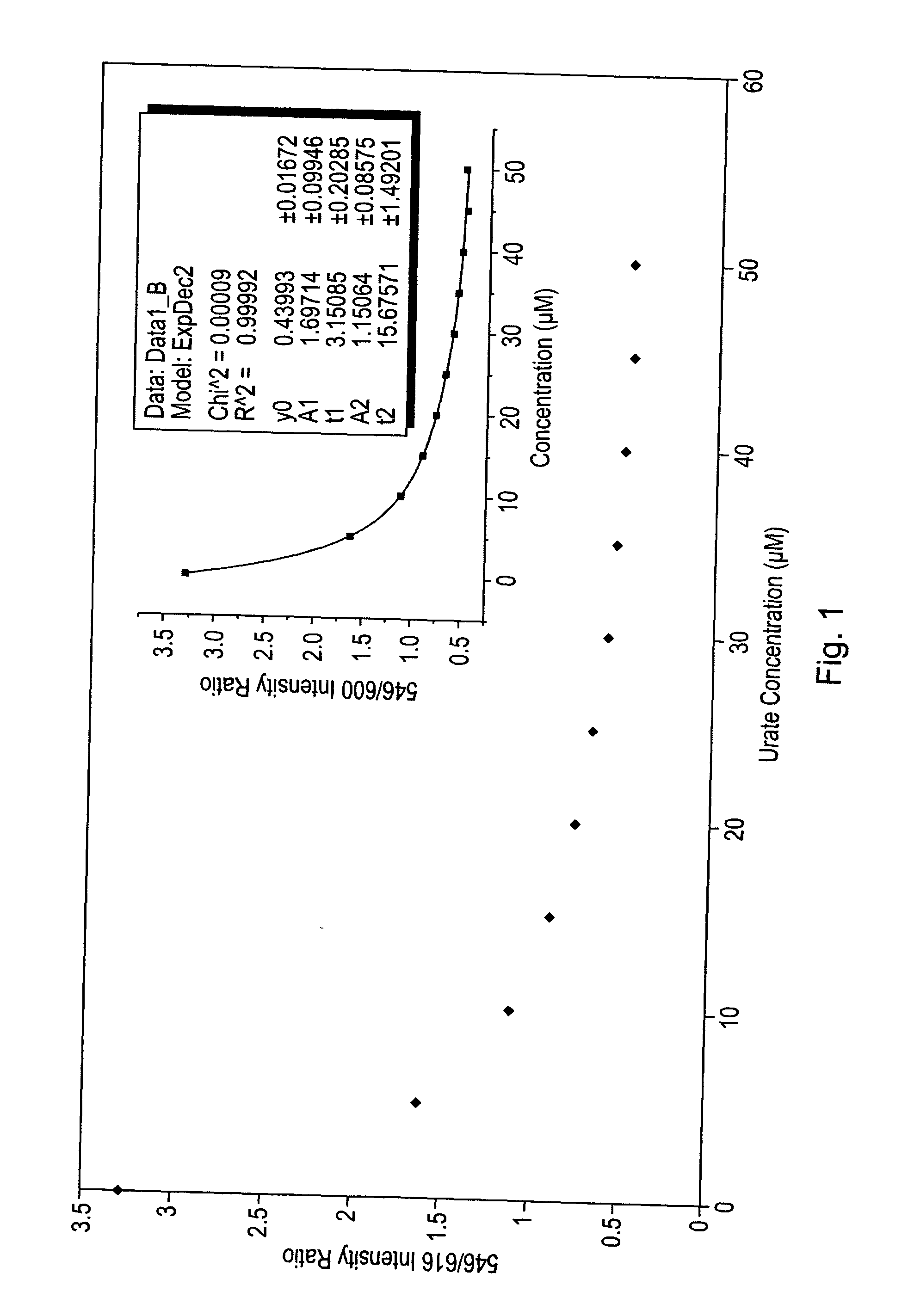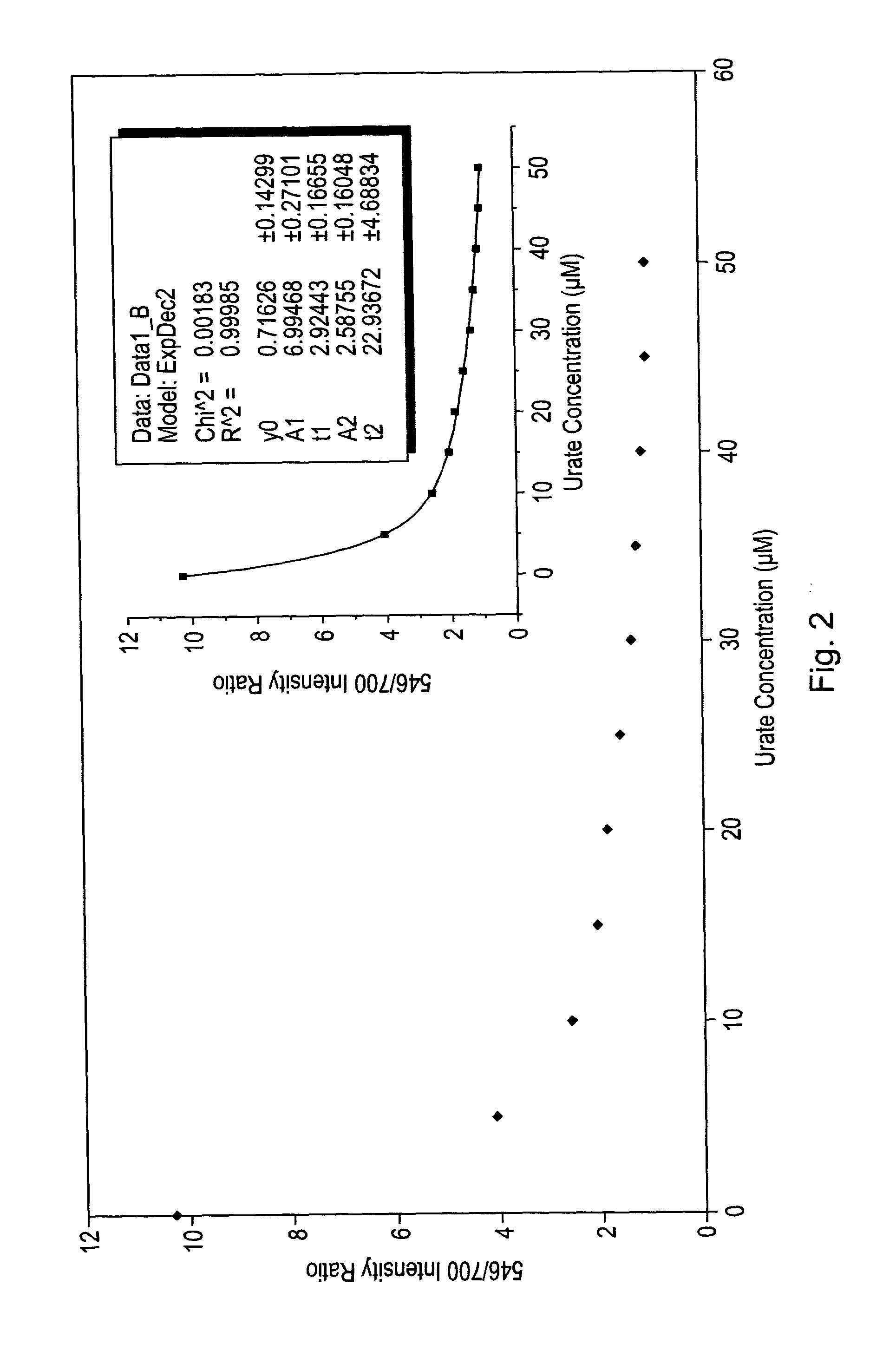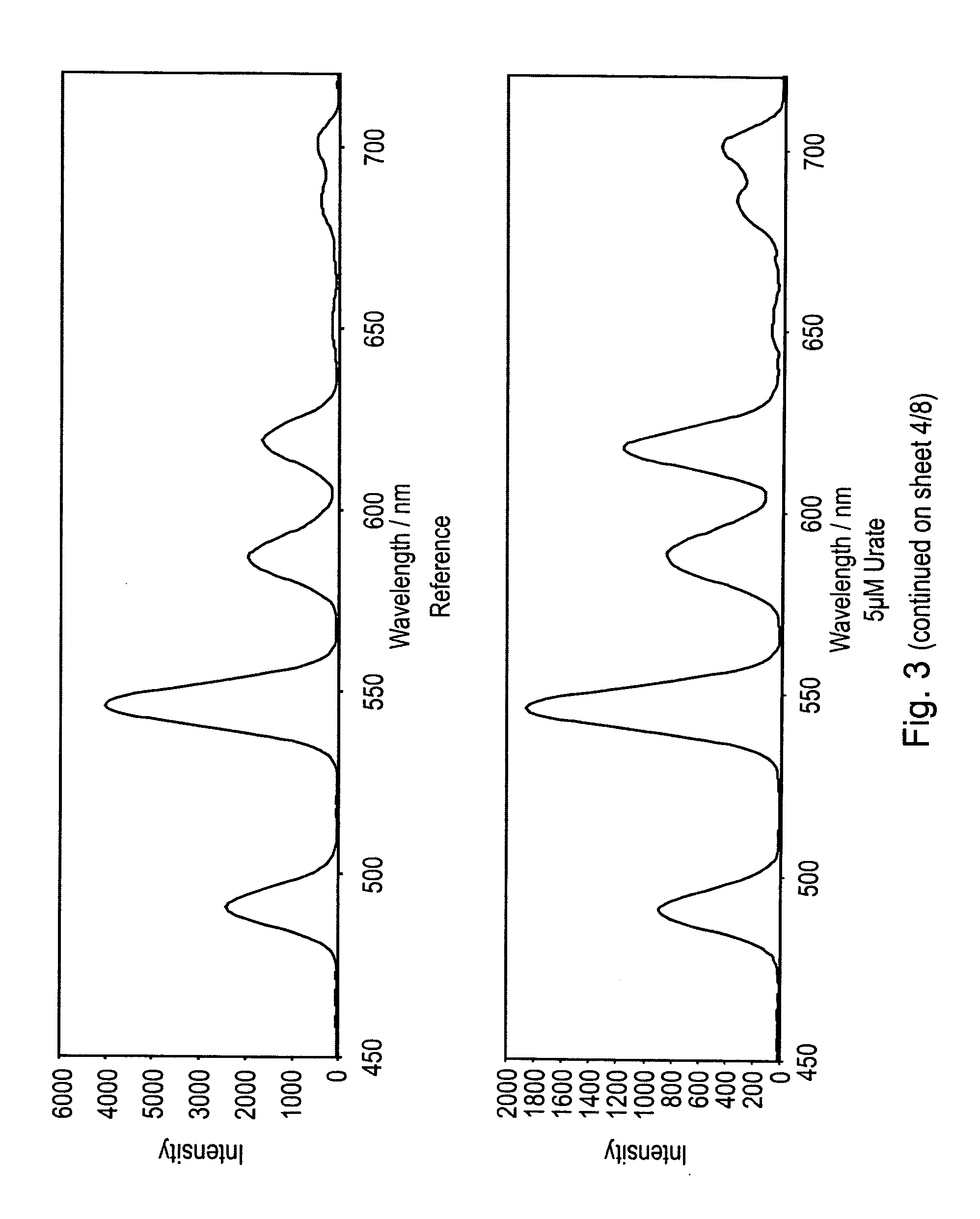Luminescence assay using macrocyclic lanthanide (III) complexes
- Summary
- Abstract
- Description
- Claims
- Application Information
AI Technical Summary
Benefits of technology
Problems solved by technology
Method used
Image
Examples
example 1
Ligand 3 and Complex 6
1-(2-Methyl-1-azaxanthone)-4,7,10-tris[(S)-1-(1-phenyl)ethylcarbamoylmethyl]-1,4,7,10-tetraazacyclododecane, 3
[0042]
[0043]2-Methyl-1-azaxanthone-1,4,7,10-tetraazacyclododecane (130 mg, 0.34 mmol), K2CO3 (236 mg, 1.70 mmol) and KI (4 mg) were dissolved in acetonitrile (10 ml) and the orange solution heated to 60° C. under argon. (S)—N-(1-phenylethyl)chloroacetamide (269 mg, 1.36 mmol, 4 equivalents) in DCM (10 ml) was added, and the reaction mixture refluxed at 60° C. for 60 hours. On cooling the solution was filtered and washed with DCM. The solution was then washed with water and dried (K2CO3). Removal of the solvent under reduced pressure yielded a crude brown oil which was purified via column chromatography (alumina, DCM→0.4% MeOH:DCM) yielding the title compound as an orange crystalline solid (208 mg, 70%), m.p. 112-113° C. δH (CDCl3) 1.45 (9H, m, 3×CH3), 2.91 (22H, m br, 8× cyclen CH2 and 3×NCH2CO), 3.79 (2H, s br, CH2-AzaH), 4.74 (1H, m br, PhCH), 5.00 (2...
example 2
Synthesis of 2 (R′=H) and 5
Diethyl 7-carboxaldehyde-dipyrido[3,2-f:2′,3′-h]quinoxaline-2,3-dicarboxylate
[0046]Selenium dioxide (480 mg, 4.33 mmol) was added to the solution of diethyl 7-methyldipyrido[3,2-a:2′,3′-c]quinoxaline-2,3-dicarboxylate (810 mg, 2.07 mmol) in dioxane (170 ml). The mixture was boiled under reflux for 4 h and was allowed to cool down afterwards. The reaction mixture was filtered through a Celite plug. The solvent was removed under reduced pressure to give the crude product, which was used without further purification. 1H NMR (200 NMR, CDCl33): δ 1.52 (6H, t, J=7.2, OCH2CH3), 4.60 (4H, q, J=7.2, OCH2), 7.92 (1H, dd, J=8.6, 4.6, H11), 8.46 (1H, d, J=8.2, H5), 9.43 (1H, dd, J=4.4, 1.8, H10), 9.61 (1H, dd, J=8.2, 1.8, H12), 9.74 (1H, dd, J=8.4, 0.8, H6), 10.60 (1H, d, J=1.0, COH). 13C NMR (75 MHz, CDCl3): δ 14.2 (CH3), 63.3 (CH2), 121.7 (C5), 125.0 (C11), 126.8 (q Ar), 129.2 (q Ar), 134.7 (C12), 136.0 (C6), 139.5 (q Ar), 141.2 (q Ar), 144.5 (q Ar), 145.3 (q Ar), 1...
example 3
Synthesis of 4 (R′=H) and 7
1,4,7-tris(benzyl-ethyloxyphosphinatomethyl)-10-tert-butyoxycarbonyl-1,4,7,10-tetraazacyclododecane
[0052]Benzyl diethoxyphosphine (1.4 g, 6.6 mmol) was added to a mixture of 1-tert-butoxycarbonyl-1,4,7,10-tetraazacyclododecane (0.4 g, 1.47 mmol) and paraformaldehyde (0.3 g) in dry THF (23 ml). The reaction mixture was heated to reflux for 8 hours. The reaction mixture was filtered and the solvent was removed under reduced pressure. The residue was purified by column chromatography on alumina (CH2Cl2 to 6% MeOH) to yield the product as an oil (0.3 g, 24%). 1H NMR (300 MHz, CDCl3): δ1.18 (9H, m, CH3), 1.39 (9H, s, C(CH3)3), 2.60-3.80 (28H, m, NCH2, PCH2), 3.95 (6H, m, OCH2), 7.30 (15H, m, phenyl). 31P NMR (120 MHz): δ 50.31 (P). m / z (ES+) 883.4 (M+Na+).
1,4,7-tris(benzyl-ethyloxyphosphinatomethyl)-1,4,7,10-tetraazacyclododecane
[0053]A solution of 1,4,7-tris(benzyl-ethyloxyphosphinatomethyl)-10-tert-butyoxycarbonyl-1,4,7,10-tetraazacyclododecane (450 mg, 0.523...
PUM
 Login to View More
Login to View More Abstract
Description
Claims
Application Information
 Login to View More
Login to View More - R&D
- Intellectual Property
- Life Sciences
- Materials
- Tech Scout
- Unparalleled Data Quality
- Higher Quality Content
- 60% Fewer Hallucinations
Browse by: Latest US Patents, China's latest patents, Technical Efficacy Thesaurus, Application Domain, Technology Topic, Popular Technical Reports.
© 2025 PatSnap. All rights reserved.Legal|Privacy policy|Modern Slavery Act Transparency Statement|Sitemap|About US| Contact US: help@patsnap.com



